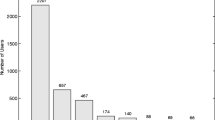Summary
In this survey, the most important aspects concerning information on airborne pollen concentrations in relation to hay fever are reported. Six of these aspects are briefly discussed. They are: target group, “spectivity”, subject exactness, routes, frequency. These aspects of information system can concern airborne pollen and/or pollinosis. The “Leiden” system has two flows of information: daily hay-fever forecast and weekly pollen bulletin.
Similar content being viewed by others
References
F.Th.M. Spieksma (1980) — Daily hay fever forecast in the Netherlands. Radio broadcasting of the expected influence of the weather on subjective complaints of hay fever sufferenrs. Allergy, 35: 593–603.
F.Th.M. Spieksma, A. van den Assem, B. J. A Collette (1985) — Airborne pollen concentration in Leiden, The Netherlands, 1977–1981. II. Poaceae (grasses), Variations and relation to hay fever. Grana, 24: 99–108
W. Dankaart, F.Th.M. Spieksma (1987) — Das woechentliche Pollenbulletin aus Helmond und Leiden. Proc. I Eur. Pollenflug-Symp. (Eds. Kersten & von Wahl); Moenchengladbach, 117–129.
Author information
Authors and Affiliations
Rights and permissions
About this article
Cite this article
Spieksma, F.T.M. Retrospective and predictive systems of information on airborne pollen concentrations in relation to hay fever. Aerobiologia 4, 8–11 (1988). https://doi.org/10.1007/BF02450025
Issue Date:
DOI: https://doi.org/10.1007/BF02450025




